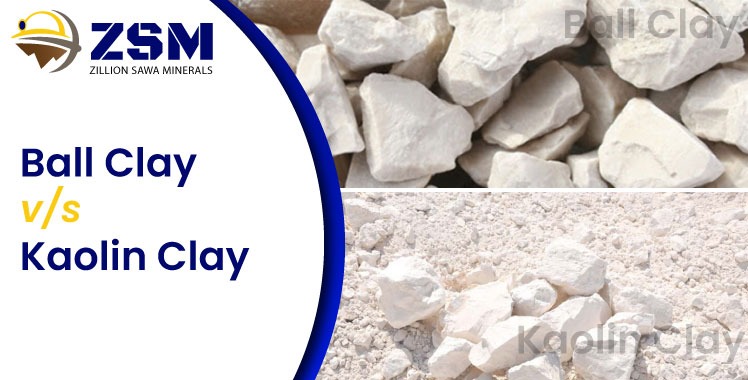
Ball Clay vs Kaolin
There are two kinds of clay. The two types are known as kaolinite and ball clay. There are many varieties of these two types of clay. In this blog we will get to know about Ball Clay benefits and Kaolin Clay benefits and ways to maintain perfect proportions for workability, plasticity and getting great colour for your products.
Kaolin Clay Benefits
The Kaolin is a very nice white clay fact, it's so white, it's used for the coating on slick paper that makes it white. the Kaolin clay kind of looks like a stack of papers, it’s what they call platelets, and they're a little bit bigger crystal. Kaolin is less plastic. Kaolin Clay benefits by making the product smooth and white.
Ball Clay Benefits
Ball clay, on the other hand, is manufactured differently and has two distinct characteristics. One is that, due to the method it was created, it contains a lot of organic components. It also has a distinct crystal structure, usually Montmorillonite, and often contains a large number of bentonites. Because the ball clay is so fine-grained, it has a much higher surface area than the Kaolin clay. As a result, the ball clay absorbs far more water than the Kaolin. The water is now chemically attracted to the clay crystals after reacting with them. However, when you combine it, there's sometimes more water, and it seeps into the interstitial spaces between the crystals. Because the ball clay is so finely grained, there is a lot of open space for water to enter, therefore it will absorb a lot more water. Now, what this implies to you is that ball clay is a lot more pliable with more water and extremely fine grains, and it lends itself better to shaping specific ways. Ball clay, for example, aids in the slip-casting process. It improves the extrusion of a mix and, for example, the ram pressing of a mix. Ball Clay benefits by increasing the plasticity of the mix and making the mix more workable.
Downsides of using the ball clay for more plasticity:
There are two downsides to the ball clay.
1. One is colour because it will always fire much darker than the white Kaolin.
2. The other is because it takes up so much water, it will shrink a great deal more when it's drying, which means it's more prone to drying cracks or warping.
Kaolin is non-plastic and to increase its plasticity (the property of a material to retain shape) a typical blend will include kaolin clay as well as a small amount of ball clay.
How to get good white colour and workability without using too much ball clay
Though using too much ball clay benefits in increasing the plasticity of a mix it negatively impacts the product due to shrinkage and colour distortion during firing, Now, if you want to keep the same product that you've been making, that's a nice white product, and you feel like you should add more ball clay to make it work, but you don't want the colour distortion and shrinkage, using organic materials in small percentages, such as ceramic flour instead of ball clay will help you maintain the balance between workability, plasticity and have a great white colour.
How to prevent shrinkage, warping and cracking?
When using a mix with more ball clay, keep an eye on how it dries and maintain it in a higher humidity setting for a longer period to allow for a slower drying process during the high shrinkage phase.
Care during drying
Drying occurs in two stages in ceramics. The first stage is where it loses all water that's in between the clay particles. In the second stage, the chemically attached water comes off after the shrinkage has stopped.
This means during drying; we need to be very careful during the first stage of drying while it's still moving. In case there is a piece that's got air blowing on it, the side that has the air blowing against it will probably dry a whole lot faster than the other side and if it's uncontrolled dry too fast, the piece is going to shrink more on the side, seeing the extra air and it'll warp that way or might even crack.
To prevent this, we need to keep air moving with a bit more moisture in the air and higher relative humidity, it will still dry, but it won't quite dry as fast, and it will keep you from getting warped or cracking.
Getting rid of organic material
Another problem that occurs is because the ball clay has a whole lot of organic material in it. We need to get that organic material out without damaging the product, which means that the organic material has to combine with oxygen and has to combust. On the other hand, we don't want it to catch fire because that causes it to expand and that will produce cracks in the product.
So, to prevent this we need to heat the product gently and easy between 400- and 750-degree Fahrenheit (204 to 399 C). This is the temperature where most of that organic material gets burned out.
If it's a real thin piece, it's going to be pretty easy to do because the heat is going to go all the way through and it's going to be a whole lot less volume of material that has to be burned up. But for real thick sections in a piece, they have to be treated carefully because it's going to take a while for the heat to penetrate. And it's going to take a while for the oxygen to penetrate, and it's going to take a while for the organic material to burn up.
Conclusion
This is simply a quick review of some of the items to consider while producing a kaolinite and ball clay mixture for making ceramic products.
